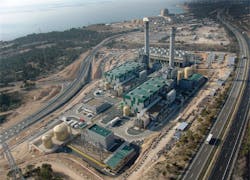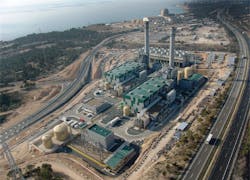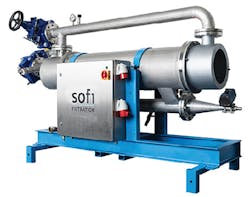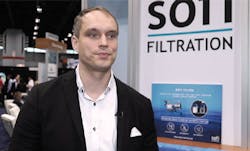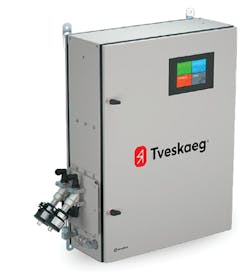Thermoelectric power generation requires approximately 160 billion gallons/day of water and is responsible for almost 50 percent of freshwater withdrawal in the U.S. Photo courtesy SUEZ.
By William Steel
Thermoelectric power generation is an industry heavily dependent on water. Although trending towards decreasing its reliance on water, the industry remains keen to keep a finger on the pulse of the latest offerings from water technology providers to ensure operations are as efficient as possible. According to Vince Tidwell of Sandia National Laboratories, thermoelectric power generation is the largest source of water withdrawal in the United States, requiring some 160 billion gallons/day. It’s responsible for almost 50 percent of freshwater withdrawal in the country.
“The leading uses are cooling, which occupies the largest share, and emissions control, which represents between 10 and 15 percent of a plant’s water consumption,” said Tidwell. “Each requires specific kinds of treatment, and systems vary greatly depending on all sorts of factors — water source, plant characteristics and operations, and regulations, for instance.”
From a water treatment perspective, cooling systems rely heavily on filtration. For all plants, filtration is applied to source water, be it fresh water, saline or brine. Additional filtration treatments are utilized in increasingly popular recirculating (or closed-loop) cooling systems to ensure operational water quality and manage salt and mineral concentration build-up, alongside other particulates.
As a means for emissions control, a principal technology is flue gas desulfurization (FGD). Here, wet scrubber FGD is the leading technology, deployed in around 85 percent of installations. FGD wastewater typically requires multiple treatment steps: initially targeting heavy metals concentrated in fine solids, and then high concentrations of dissolved solids.
Across the wide spectrum of water systems founds in power contexts, Tidwell suggested that “regulation is really what drives plants to make system changes, but people are always careful with new technologies, cautious of them living up to expectations.”
Bill Heins, head of new market development at SUEZ Water Technologies & Solutions, holds a similar opinion, but noted that the power sector is a responsive one. “Overall there’s a good recognition of advances in water systems by plant operators,” he said. “Technologies are always changing and we’re always looking at the next generation of innovation. It’s important for us to communicate that changing landscape to the industry.”
With this in mind, Heins said that SUEZ’s approach involves “looking towards future requirements and planning many years in advance.” It’s a philosophy evident in how SUEZ has positioned itself to handle new regulations imposed by the U.S. EPA’s Effluent Limitation Guidelines (ELGs) where compliance requires the treatment of FGD wastewater for removal of arsenic, mercury, chlorides, selenium, and nitrates/nitrites.
“Certainly, regulatory drivers are key. The ELGs are just one example, albeit a large one,” said Heins. “They’re a long time in the making, so we’ve been working for a long time with the industry and regulators to demonstrate what the Best Available Techniques (BATs) are.”
Heins explained that SUEZ offer complete solutions for plants that must adopt either treat-and-discharge or Zero Liquid Discharge (ZLD) regulations. “If a plant is going to be treating and discharging water, the BAT is a combination of physical and chemical treatment followed by downstream biological treatment. As GE Water, now SUEZ, we developed the ABMet® biological treatment solution — one called out as a BAT for existing coal-fired plants taking the discharge route.”
The ABMet system targets nitrates/nitrites and selenium removal in a single step, after treatment for mercury via chemical-based MetClear. A prototypical deployment of the system at American Electric Power’s 1.3 GW Mountaineer power plant (New Haven, W.Va.) demonstrates its performance: surpassing FGD effluent discharge limits with selenium levels below 10 ppb, alongside reduction of nitrates/nitrites, and effluent TSS below 30 ppm.
For new plants, Heins said, “Our ZLD FGD wastewater solution involves a combination of evaporation followed by solidification to recover wastewater and solidify it into something that can be landfilled. It’s the BAT for new plants or plants taking advantage of the ELG incentive program.”
While thermal ZLD processes are aimed at total dissolved solids such as boron and other inorganic constituents, SUEZ’s novel approach to thermal ZLD utilizes a solidification stabilization process with several advantages. Notably, solidification replaces the crystallization step found in traditional thermal ZLD; this in turn allows for removal of a softening step (for calcium removal), which was required to enable subsequent crystallization.
“Altogether the innovation has enabled meeting not only ELGs but a substantial reduction in CAPEX (of 30-50 percent) and OPEX (of 20-40 percent) relative to traditional thermal ZLD approaches,” said Heins.
The Sofi Filter system is a fully-automated, chemical-free, self-cleaning filtration system well suited for FGD wastewater treatment.
The end result is a stable, load-bearing byproduct which minimizes landfill concerns.
Crossing the Finnish Line
As one might expect, innovation is especially strong in the smaller, up-and-coming companies.
Finland’s Sofi Filtration is one company offering innovative approaches to FGD wet scrubber wastewater treatment. The company’s Sofi Filter system is a fully-automated, chemical-free, self-cleaning filtration system that claims to supersede traditional systems by a wide margin.
Ville Hakala, Sofi Filtration CEO, said, “The Sofi Filter provides an alternative to conventional FGD wastewater treatment. We’ve only recently moved into the market but we’ve found that the power industry’s requirements are right in Sofi Filtration’s sweet spot — it’s a killer application for us.” Hakala said the company has sold seven units in the last year and is excited about more activity in the market.
Ville Hakala, CEO, Sofi Filtration.
The company initially marketed its Sofi Filter as a solution for recirculation in district heating. Having found success there, the company delivered its first FGD wastewater system in 2016.
“The most significant problem is that flue gas wastewater has high solids loading with very small particle sizes,” Hakala explained. “It’s also highly dynamic, meaning that the demands on the system can vary considerably. Traditional systems can really struggle with this and so require two or three process trains, which increases CAPEX and OPEX.”
In contrast, Hakala said that the Sofi Filter design means it copes well with a highly dynamic range in feed. “In technical terms, we’re operating at another level compared to traditional systems. Our system can handle solids down to 0.3 microns, and up to 10 microns without clogging.” According to Hakala, with inlet water having a TSS concentration of 200 ppm/L, effluent from Sofi at or below 10 ppm/L is possible. “That’s typically the discharge limit in Finland so it meets requirements.”
Hakala said the system can replace up to three of the traditional phases of particle filtration whilst still achieving results “sufficient for wastewater to be discharged but not necessarily reused.” He added that the company is piloting reuse solutions which may involve nanofiltration or reverse osmosis (RO) in combination with the Sofi Filter.
NanoNord has developed the world’s first online Nuclear Magnetic Resonance (NMR) sensor technology — it’s like an MRI for water.
Key to its performance, the system features a metal mesh, patented cross-flow design coupled with an ultrasonic cleaning system. “The cross-flow design accelerates the flow of wastewater over filter elements with micropores,” Hakala explained. “The greater the velocity over the filter, the higher the shearing effects; the clean water cuts through micropores. The cross-flow also keeps the filter surface clean. At the same time, a very powerful integrated ultrasonic resonator works to help keep the pores clear from smaller particles.”
He added: “The beauty of the system is that it can actually self-clean while operational and doesn’t require disposable filter changes.”
Hakala provided insight on performance in an FGD wastewater setting: “With 2,200 mg/L TSS, we’re achieving 10 mg/L TSS in filtrate with a 1-micron filter element.”
The efficient design is translating into good economic results too, according to Hakala. “FGD operations are typically between 5 and 10 m3/hour. With Sofi, at a smaller scale we’re talking less than €0.30/cubic meter, including CAPEX and OPEX. That cost comes down to below €0.10/cubic meter at higher flow rates.”
Hakala believes that alongside its high performance, Sofi Filtration is hitting all the right points in terms of the key drivers for innovation. “Power plant operators want a high level of automation with low maintenance and low attendance. It doesn’t get much simpler than Sofi.”
He continued: “Reduced OPEX is also key and being chemical-free is very attractive — as is not requiring pressure to push water, as this reduces energy demand. The low need for manual intervention is another big win and a huge improvement over traditional systems.”
Lastly, Hakala highlighted the importance of size. “Many times, you’re retrofitting systems, so a compact size is also a great benefit.” About 1.9 m tall and 0.5 m in diameter, the Sofi Filter can be readily installed into existing infrastructure. “It’s a modular system, too, so in a twenty-foot container we can fit eight Sofi modules to achieve about 100 m3/hour treated capacity.”
Like an MRI for Water
Cutting-edge innovation is also present in the field of sensor technologies deployed to detect and quantify contaminants. Denmark-based NanoNord stands at the forefront of the field having developed the world’s first online Nuclear Magnetic Resonance (NMR) sensor technology.
The technology, termed Tveskaeg, is applied in NanoNord’s three products: Tveskaeg, Tveskaeg Benchtop, and CatGuard Tveskaeg.
NMR involves exposing samples with a high magnetic field, while simultaneously emitting and receiving radio waves between 1 and 70 MHz — similar to medical MRI. The system identifies NMR isotopes by unique NMR frequency, and by way of digital signal processing enables precise measurement of isotopes in their relevant chemical bindings.
According to NanoNord CEO Ole Jensen, “You can measure nearly anything — if it can be pumped through our 9-mm borehole, it can be analyzed. The NMR platform could replace a wide number of existing sensor types and has an incredible number of industrial uses in water, wastewater and fuel applications.”
With quality of water and fuel a high priority, online knowledge of the content of these process liquids, as well as sludge and wastewater, is highly valuable to operators of power plant systems — allowing them to better calibrate systems, plan treatments and assure them of meeting quality or environmental regulations.
Over 100 isotope frequencies, covering most atomic numbers, can be targeted with Tveskaeg, including dissolved nitrogen, sulfur, small molecule carbons, phosphates, chloride, sodium, potassium — many of which are relevant in FGD wastewater as dissolved solids requiring treatment.
Expanding on this, Jensen said, “Many heavy metals are also within reach with Tveskaeg, including arsenic, lead, aluminum, and copper. The technology’s sensitivity is influenced by many factors, and stronger for some isotopes than others, but for most it can detect at the few-parts-per-million range.”
Jensen highlighted the example of phosphorus measurement. “Optical sensors only measure the free PO4 component and multiply with a fixed factor to get ‘total phosphorus’ that authorities need. Tveskaeg NMR measures both PO4 and bound PO4 components as well as most other bound P components. All are provided as separate readings of the ‘real’ numbers, which governments and operators need.”
Ole Jensen, CEO, NanoNord.
Precision isn’t the only advantage of Tveskaeg; another key benefit is durability. “The technology fits perfectly in all dirty ‘soups’ that need to be analyzed and which were hard or impossible to analyze due to lack of reliable sensors for the field.”
More conventional sensors require being in direct contact with the substance under examination; others are dependent on windows, which must remain clean. Many sensor technologies don’t survive long in these environments without continual and expensive maintenance, said Jensen.
Tveskaeg, however, is virtually contact-free, with substances only coming into contact with a Teflon™ pipe. “There’s no degradation, and less maintenance which reduces the overall cost of an NMR-based measuring system to below that of other solutions.”
There are some limitations, however. “The present Tveskaeg generation cannot replace all existing sensors due to a lack of sensitivity for some isotopes,” Jensen acknowledged. It’s also not yet approved for effluent analysis applications for the purpose of regulatory compliance. “Presently we’re targeting process monitoring applications,” said Jensen. “But NanoNord expects to overcome this hurdle in coming years.” IWW
About the Author: William Steel is a freelance reporter based in Denmark covering the development and happenings of renewable energy, water and clean-tech industries. In addition to contributing to various trade journals, he writes about other fields of technology and science at his website, www.phlebas.co.
